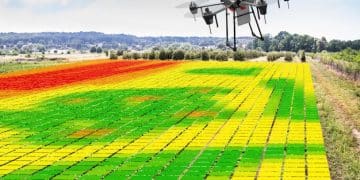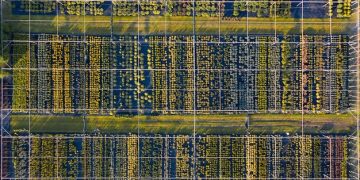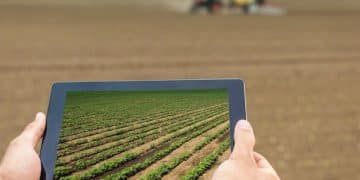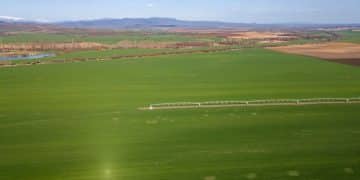Reduce Fertilizer Costs: A Farmer’s Guide to Soil Sensors

Reduce fertilizer costs by 20% by implementing soil sensors for precision nutrient management, improving crop yields and promoting sustainable farming practices in the US.
Can soil sensors really help you reduce fertilizer costs by 20%? For US farmers, understanding soil health is key to efficient farming. This guide explores how soil sensors can optimize fertilizer use, saving money and improving crop yields.
Understand the Basics of Soil Sensors
Soil sensors are revolutionizing agriculture by providing real-time data about soil conditions. This information allows farmers to make informed decisions about fertilizer application, leading to significant cost savings and environmental benefits.
These devices measure various parameters such as moisture levels, nutrient content (nitrogen, phosphorus, potassium), pH, and temperature. By understanding these factors, farmers can tailor their fertilizer applications to meet the specific needs of their crops, avoiding over- or under-fertilization.
Types of Soil Sensors
There are several types of soil sensors available, each with its own strengths and applications. Let’s explore some of the main types:
- Electrochemical Sensors: These measure nutrient levels and pH by detecting electrical conductivity in the soil.
- Dielectric Sensors: These measure soil moisture content based on the dielectric properties of the soil.
- Optical Sensors: These use light to analyze soil properties, such as organic matter content and nutrient levels.
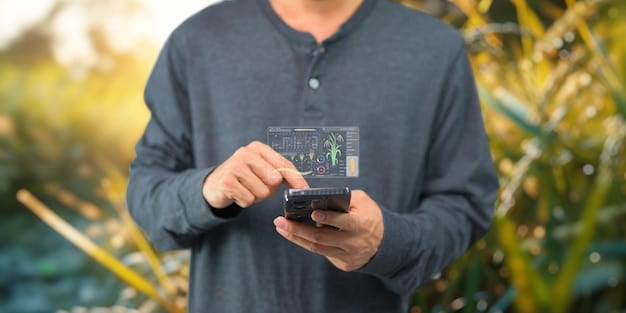
Choosing the right sensor depends on your specific needs and the type of crops you’re growing. Consider factors such as accuracy, durability, and ease of use when making your selection.
In conclusion, understanding the basics of soil sensors is essential for any farmer looking to optimize fertilizer use. By monitoring key soil parameters, you can make data-driven decisions that save money and improve crop yields.
How Soil Sensors Reduce Fertilizer Costs
The primary way soil sensors help reduce fertilizer costs by 20% is by enabling precision nutrient management. Traditional farming methods often involve applying fertilizer uniformly across an entire field, regardless of variations in soil conditions.
Soil sensors provide detailed information about the specific nutrient needs of different areas within a field. This allows farmers to apply fertilizer only where it’s needed, and in the right amounts. By avoiding over-fertilization, you can significantly reduce your fertilizer costs.
Benefits of Precision Nutrient Management
Precision nutrient management offers several key benefits:
- Reduced Fertilizer Waste: Applying fertilizer only where it’s needed minimizes waste and ensures that nutrients are used efficiently.
- Improved Crop Yields: By providing the right amount of nutrients, you can optimize crop growth and increase yields.
- Environmental Protection: Reducing fertilizer runoff helps protect water quality and minimize the environmental impact of farming.
Implementing soil sensors also allows for real-time adjustments to fertilizer application. As soil conditions change throughout the growing season, you can use sensor data to fine-tune your fertilization strategy.
In simple terms, soil sensors give farmers the ability to make smarter, more informed decisions about fertilizer use. The result being less waste, improved efficiency, and significant cost savings.
Implementing Soil Sensors on Your Farm
Implementing soil sensors on your farm involves several steps, from selecting the right sensors to integrating them into your existing farming practices. Proper planning and training are essential for success.
First, assess your specific needs and determine which soil parameters are most important for your crops. Once you have a clear understanding of your requirements, you can evaluate different sensor options and choose the ones that best fit your needs and budget.
Steps to Implementation
Here’s a step-by-step guide to implementing soil sensors:
- Assess Your Needs: Identify the specific soil parameters you need to monitor, such as moisture, nitrogen, phosphorus, potassium, and pH.
- Choose the Right Sensors: Select sensors that are accurate, durable, and easy to use. Consider factors such as cost, battery life, and data connectivity.
- Install the Sensors: Follow the manufacturer’s instructions for installing the sensors in your fields. Ensure that the sensors are properly calibrated and positioned for accurate readings.
- Collect and Analyze Data: Use a data platform to collect and analyze the sensor data. Look for trends and patterns that can inform your fertilizer application decisions.
Training your team on how to use and interpret the sensor data is also vital. This ensures that everyone understands how to use the information to make informed decisions.
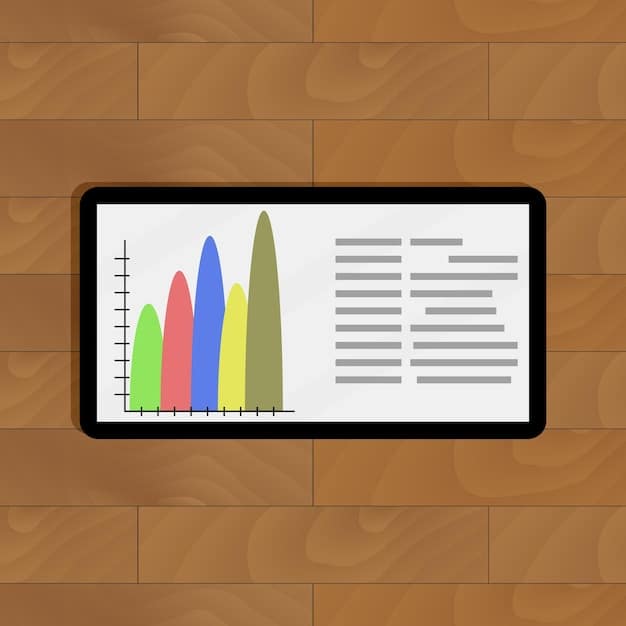
By following these steps, you can successfully implement soil sensors on your farm and start reaping the benefits of precision nutrient management.
Choosing the Right Soil Sensor Technology
Selecting the right soil sensor technology is a critical decision that can significantly impact your farm’s efficiency and profitability. With a variety of sensors available, it’s essential to consider your specific needs and priorities.
Consider the type of data you need to collect. Do you need to monitor just moisture levels, or do you also need to measure nutrient content and pH? The sensors you choose should be capable of accurately measuring the parameters that are most important for your crops.
Factors to Consider When Choosing Soil Sensors
Here are some crucial factors to consider:
- Accuracy: The sensor should provide accurate and reliable data.
- Durability: The sensor should be able to withstand the harsh conditions of a farm environment, including exposure to moisture, extreme temperatures, and physical damage.
- Ease of Use: The sensor should be easy to install, maintain, and use.
- Cost: The sensor should be affordable and provide a good return on investment.
Consider the connectivity options offered by different sensors. Some sensors transmit data wirelessly, others require manual data download. Consider the compatibility of the sensor with your existing farming equipment and software.
Choosing the right soil sensor technology requires careful consideration of your needs and priorities. Evaluate your options and select the sensors that best fit your requirements.
Integrating Sensor Data with Farm Management Systems
Integrating soil sensor data with your farm management systems can streamline your operations and improve decision-making. By connecting your sensors to a central data platform, you can access real-time information about soil conditions from anywhere.
This integration enables you to make more informed decisions about fertilizer application, irrigation, and other farming practices. You can also track the effectiveness of your management strategies and make adjustments as needed.
Benefits of Data Integration
Here are some of the benefits of integrating sensor data with farm management systems:
- Improved Decision-Making: Access to real-time data allows you to make more informed decisions about fertilizer application, irrigation, and other farming practices.
- Streamlined operations: Automation and integration can streamline your operations and reduce manual labor requirements.
- Increased Efficiency: By optimizing resource use, you can increase efficiency and reduce costs.
When choosing a farm management system, look for one that is compatible with your soil sensors and other farming equipment. The system should be user-friendly and offer features that are relevant to your needs.
Integrating sensor data with your farm management systems can transform your operations and improve your bottom line. Take the time to find the right system for your needs and start taking advantage of the power of data-driven decision-making.
Real-World Examples of Cost Savings
While the theory behind soil sensors is compelling, seeing real-world examples can solidify their value. Many farms across the US have already achieved significant cost savings by implementing soil sensor technology.
For example, a corn farmer in Iowa reduced their fertilizer costs by 22% after implementing soil sensors. By applying nitrogen only where it was needed, they saved thousands of dollars and improved their yields.
Success Stories from US Farmers
Here are a few notable examples:
- Iowa Corn Farmer: Reduced nitrogen fertilizer costs by 22% and improved yields by 5%.
- California Almond Grower: Saved 15% on irrigation costs by monitoring soil moisture levels and optimizing irrigation schedules.
- Florida Citrus Farmer: Reduced phosphorus fertilizer costs by 18% and improved fruit quality by monitoring soil pH levels.
These success stories demonstrate that soil sensors can deliver real, measurable results. By implementing this technology on your farm, you too can achieve significant cost savings and improve your bottom line.
Soil sensors are not just a futuristic concept; they are a practical tool that can help farmers improve efficiency, reduce costs, and promote sustainable farming practices. With the right sensors and a well-planned implementation strategy, you can achieve a significant return on your investment.
Future Trends in Soil Sensor Technology
The field of soil sensor technology is constantly evolving, with new innovations emerging all the time. Staying informed about future trends can help you make smart investment decisions and stay ahead of the curve.
One major trend is the development of more advanced and versatile sensors. These sensors will be able to measure a wider range of soil parameters, providing even more detailed information about soil conditions.
Emerging Technologies
Here’s a glimpse into the future of soil sensor technology:
- Drones with Soil Sensors: Drones equipped with soil sensors can quickly and efficiently collect data across large areas, providing a comprehensive overview of soil conditions.
- Artificial Intelligence (AI): AI algorithms can analyze sensor data and provide real-time recommendations for fertilizer application, irrigation, and other farming practices.
- Internet of Things (IoT): The IoT is enabling seamless connectivity between sensors, farm equipment, and management systems, further streamlining operations and improving efficiency.
As soil sensor technology continues to advance, it will play an increasingly important role in helping farmers optimize resource use, reduce costs, and promote sustainable farming practices.
These sensors will become more integrated into farm management systems, providing farmers with real-time insights and data-driven recommendations. By embracing these technologies, you can position your farm for success in the years to come.
| Key Point | Brief Description |
|---|---|
| 🌱 Precision Farming | Use soil sensors to measure nutrients, tailoring fertilizer to specific needs. |
| 💸 Cost Reduction | Avoid over-fertilization by applying nutrients only where needed, saving money. |
| 📊 Data Integration | Connect sensor data to farm management systems for real-time insights. |
| 🛰️ Emerging Tech | Explore drones and AI to enhance soil monitoring and decision-making. |
FAQ
▼
Soil sensors are devices used to measure soil properties like moisture, nutrient levels, pH, and temperature. The sensors provide farmers with real-time data on soil conditions, enabling precise nutrient management and minimizing fertilizer waste.
▼
Soil sensors reduce costs by providing data that allows farmers to apply fertilizer only where needed and in the correct amounts. This precision avoids over-fertilization, leading to significant savings.
▼
There are various types, including electrochemical sensors (measuring nutrients and pH), dielectric sensors (soil moisture), and optical sensors (organic matter and nutrient levels). Each type suits different needs and applications.
▼
Integrate sensor data by using compatible farm management software. This allows real-time access to data, which helps in making informed decisions on fertilizer application and other farm practices, streamlining operations.
▼
Future trends include drones with sensors, AI for data analysis, and the Internet of Things (IoT) for seamless connectivity. These advancements offer detailed insights and improve the efficiency of farming practices.
Conclusion
By leveraging soil sensor technology, US farmers can significantly reduce fertilizer costs by 20%, enhance crop yields, and promote sustainable agricultural practices. Adopting these tools ensures a more efficient, profitable, and environmentally responsible future for farming.
